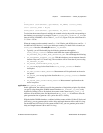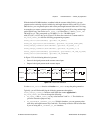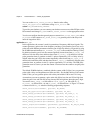
Chapter 2 Function Reference — GPCTR_Set_Application
NI-DAQ FRM for PC Compatibles 2-228
©
National Instruments Corporation
For example, assume that you want to generate a pulse 200 ns long after 150 ns of delay.
You need to set
ND_COUNT_1 to 150 ns/50 ns = 3 and ND_COUNT_2 to 200 ns/50 ns = 4.
Figure 2-19 shows the scenario of a counter used for
ND_SINGLE_PULSE_GNR after the
following programming sequence:
GPCTR_Control(deviceNumber, gpctrNum, ND_RESET)
GPCTR_Set_Application(deviceNumber, gpctrNum, ND_SINGLE_PULSE_GNR)
GPCTR_Change_Parameter(deviceNumber, gpctrNum, ND_COUNT_1, 3)
GPCTR_Change_Parameter(deviceNumber, gpctrNum, ND_COUNT_2, 4)
Select_Signal(deviceNumber, gpctrNumOut, gpctrNumOut,ND_LOW_TO_HIGH)
GPCTR_Control(deviceNumber, gpctrNum, ND_PROGRAM)
In Figure 2-19, the following behavior is present:
• Source is the signal present at the counter source input.
• Output is the signal present at the counter output.
• Armed is the value you would read from the counter if you called the
GPCTR_Watch
function with entityID =
ND_ARMED. The different values illustrate behavior at different
times.
Figure 2-19.
Single Pulse Generation
Use the GPCTR_Watch function with entityID = ND_ARMED to monitor the progress of the
pulse generation process. The generation completes when entityValue becomes
ND_NO.
Typically, you find modifying of the following parameters through the
GPCTR_Change_Parameter function useful when the counter application is
ND_SINGLE_PERIOD_MSR. You can change the following:
•
ND_COUNT_1 and ND_COUNT_2 to any value between 2 and 2
24
– 1 for E Series and 445X
devices, and to any value between 2
32
– 1 for 6602 and 455X devices. The defaults are
given for illustrative purposes only.
•
ND_SOURCE to ND_INTERNAL_100_KHZ. With this timebase, you can generate pulses
with a delay and length between 20 µs and 160 s for E Series and 445X devices and
Source
Armed
No
Output
No
Count_1 = 3
Count_2 = 4
Yes


















